-
LMP202x Zero-Drift, Low-Noise, EMI-Hardened Amplifiers
- 1 Features
- 2 Applications
- 3 Description
- 4 Revision History
- 5 Pin Configuration and Functions SC-70 and VSSOP references from LMP2021 pinout descriptions
- 6 Specifications
- 7 Detailed Description
- 8 Application and Implementation
- 9 Power Supply Recommendations
- 10Layout
- 11Device and Documentation Support
- 12Mechanical, Packaging, and Orderable Information
- IMPORTANT NOTICE
Package Options
Mechanical Data (Package|Pins)
Thermal pad, mechanical data (Package|Pins)
Orderable Information
LMP202x Zero-Drift, Low-Noise, EMI-Hardened Amplifiers
1 Features
- Input Offset Voltage (Typical) −0.4 µV
- Input Offset Voltage (Max) ±5 µV
- Input Offset Voltage Drift (Typical) –0.004 µV/°C
- Input Offset Voltage Drift (Max) ±0.02 µV/°C
- Input Voltage Noise, AV = 1000 11 nV/√Hz
- Open Loop Gain 160 dB
- CMRR 139 dB
- PSRR 130 dB
- Supply Voltage Range 2.2 V to 5.5 V
- Supply Current (per Amplifier) 1.1 mA
- Input Bias Current ±25 pA
- GBW 5 MHz
- Slew Rate 2.6 V/µs
- Operating Temperature Range −40°C to 125°C
- 5-Pin SOT-23, 8-Pin VSSOP and 8-Pin SOIC Packages
(Typical Values, TA = 25°C, VS = 5 V)
2 Applications
- Precision Instrumentation Amplifiers
- Battery Powered Instrumentation
- Thermocouple Amplifiers
- Bridge Amplifiers
3 Description
The LMP2021 and LMP2022 are single and dual precision operational amplifiers offering ultra low input offset voltage, near zero input offset voltage drift, very low input voltage noise and very high open loop gain. They are part of the LMP™ precision family and are ideal for instrumentation and sensor interfaces.
The LMP202x has only 0.004 µV/°C of input offset voltage drift, and 0.4 µV of input offset voltage. These attributes provide great precision in high accuracy applications.
The proprietary continuous auto zero correction circuitry ensures impressive CMRR and PSRR, removes the 1/f noise component, and eliminates the need for calibration in many circuits.
With only 260 nVPP (0.1 Hz to 10 Hz) of input voltage noise and no 1/f noise component, the LMP202x are suitable for low frequency applications such as industrial precision weigh scales. The extremely high open loop gain of 160 dB drastically reduces gain error in high gain applications. With ultra precision DC specifications and very low noise, the LMP202x are ideal for position sensors, bridge sensors, pressure sensors, medical equipment and other high accuracy applications with very low error budgets.
The LMP2021 is offered in 5-Pin SOT-23 and 8-Pin SOIC packages. The LMP2022 is offered in 8-Pin VSSOP and 8-Pin SOIC packages.
Device Information(1)
| PART NUMBER | PACKAGE | BODY SIZE (NOM) |
|---|---|---|
| LMP2021 | SOIC (8) | 4.90 mm x 3.91 mm |
| SOT-23 (5) | 2.90 mm x 1.60 mm | |
| LMP2022 | SOIC (8) | 4.90 mm x 3.91 mm |
| VSSOP (8) | 3.00 mm x 3.00 mm |
- For all available packages, see the orderable addendum at the end of the datasheet.
Bridge Amplifier

4 Revision History
Changes from F Revision (December 2014) to G Revision
- Deleted SC-70 and VSSOP references from LMP2021 pinout descriptions Go
- Deleted DCK and DGK packages and corrected SOT-23 pin function table for LMP2021 Go
Changes from E Revision (March 2013) to F Revision
- Added Pin Configuration and Functions section, ESD Ratings table, Feature Description section, Device Functional Modes, Application and Implementation section, Power Supply Recommendations section, Layout section, Device and Documentation Support section, and Mechanical, Packaging, and Orderable Information section Go
Changes from D Revision (March 2013) to E Revision
- Changed layout of National Data Sheet to TI formatGo
5 Pin Configuration and Functions



Pin Functions: LMP2021
| PIN | I/O | DESCRIPTION | ||||
|---|---|---|---|---|---|---|
| NAME | LMP2021 | |||||
| DBV | D | |||||
| OUT | 1 | 6 | I | Output | ||
| +IN | 3 | 3 | I | Non-Inverting Input | ||
| -IN | 4 | 2 | O | Inverting Input | ||
| V- | 2 | 4 | P | Negative Supply | ||
| V+ | 5 | 7 | P | Positive Supply | ||
| N/C | - | 1 | - | No Internal Connection | ||
| N/C | - | 5 | - | No Internal Connection | ||
| N/C | - | 8 | - | No Internal Connection | ||
Pin Functions: LMP2022
| PIN | I/O | DESCRIPTION | |||
|---|---|---|---|---|---|
| NAME | LMP2022 | ||||
| D, DGK |
|||||
| +IN A | 3 | I | Non-Inverting input, channel A | ||
| +IN B | 5 | I | Non-Inverting input, channel B | ||
| –IN A | 2 | I | Inverting input, channel A | ||
| –IN B | 6 | I | Inverting input, channel B | ||
| OUT A | 1 | O | Output, channel A | ||
| OUT B | 7 | O | Output, channel B | ||
| V+ | 8 | P | Positive (highest) power supply | ||
| V– | 4 | P | Negative (lowest) power supply | ||
6 Specifications
6.1 Absolute Maximum Ratings(1)(2)
| MIN | MAX | UNIT | ||
|---|---|---|---|---|
| VIN Differential | –VS | VS | ||
| Supply Voltage (VS = V+ – V−) | 6.0 | V | ||
| All Other Pins | V+ + 0.3 | V− − 0.3 | V | |
| Output Short-Circuit Duration to V+ or V−(3) | 5 | seconds | ||
| Junction Temperature(4) | 150 | °C | ||
| Soldering Information | Infrared or Convection (20 sec) | 235 | °C | |
| Wave Soldering Lead Temperature (10 sec) | 260 | °C | ||
| Tstg | Storage temperature range | −65 | 150 | °C |
6.2 ESD Ratings
| VALUE | UNIT | |||
|---|---|---|---|---|
| V(ESD) | Electrostatic discharge | Human body model (HBM), per ANSI/ESDA/JEDEC JS-001, all pins(1) | ±2000 | V |
| Charged device model (CDM), per JEDEC specification JESD22-C101, all pins(2) | ±1000 | |||
| Machine model | ±200 | |||
6.3 Recommended Operating Conditions
over operating free-air temperature range (unless otherwise noted)| MIN | MAX | UNIT | ||
|---|---|---|---|---|
| Temperature Range | −40 | 125 | °C | |
| Supply Voltage (VS = V+ – V–) | 2.2 | 5.5 | V | |
6.4 Thermal Information
| THERMAL METRIC(1) | LMP2021, LMP2022 | LMP2021 | LMP2022 | UNIT | |
|---|---|---|---|---|---|
| D | DBV | DGK | |||
| 8 PINS | 5 PINS | 8 PINS | |||
| RθJA | Junction-to-ambient thermal resistance | 106 | 164 | 217 | °C/W |
6.5 Electrical Characteristics: 2.5 V(1)
Unless otherwise specified, all limits are ensured for TA = 25°C, V+ = 2.5 V, V− = 0 V, VCM = V+/2, RL >10 kΩ to V+/2.| PARAMETER | TEST CONDITIONS | MIN(3) | TYP(2) | MAX(3) | UNIT | ||
|---|---|---|---|---|---|---|---|
| VOS | Input Offset Voltage | –5 | –0.9 | 5 | μV | ||
| –40°C ≤ TJ ≤ 125°C | –10 | 10 | |||||
| TCVOS | Input Offset Voltage Drift(4) | –0.02 | 0.001 | 0.02 | μV/°C | ||
| IB | Input Bias Current | –100 | ±23 | 100 | pA | ||
| –40°C ≤ TJ ≤ 125°C | –300 | 300 | |||||
| IOS | Input Offset Current | –200 | ±57 | 200 | pA | ||
| –40°C ≤ TJ ≤ 125°C | –250 | 250 | |||||
| CMRR | Common Mode Rejection Ratio | −0.2 V ≤ VCM ≤ 1.7 V, 0 V ≤ VCM ≤ 1.5 V | 105 | 141 | dB | ||
| −0.2 V ≤ VCM ≤ 1.7 V, 0 V ≤ VCM ≤ 1.5 V, –40°C ≤ TJ ≤ 125°C | 102 | ||||||
| CMVR | Input Common-Mode Voltage Range | Large Signal CMRR ≥ 105 dB | −0.2 | 1.7 | V | ||
| Large Signal CMRR ≥ 102 dB, –40°C ≤ TJ ≤ 125°C | 0 | 1.5 | |||||
| EMIRR | Electro-Magnetic Interference Rejection Ratio(3) | IN+ and IN− | VRF-PEAK = 100 mVP (−20 dBVP) f = 400 MHz |
40 | dB | ||
| VRF-PEAK = 100 mVP (−20 dBVP) f = 900 MHz |
48 | ||||||
| VRF-PEAK = 100 mVP (−20 dBVP) f = 1800 MHz |
67 | ||||||
| VRF-PEAK = 100 mVP (−20 dBVP) f = 2400 MHz |
79 | ||||||
| PSRR | Power Supply Rejection Ratio | 2.5 V ≤ V+ ≤ 5.5 V, VCM = 0 | 115 | 130 | dB | ||
| 2.5 V ≤ V+ ≤ 5.5 V, VCM = 0 , –40°C ≤ TJ ≤ 125°C | 112 | ||||||
| 2.2 V ≤ V+ ≤ 5.5 V, VCM = 0 | 110 | 130 | |||||
| AVOL | Large Signal Voltage Gain | RL = 10 kΩ to V+/2, VOUT = 0.5 V to 2 V | 124 | 150 | dB | ||
| RL = 10 kΩ to V+/2, VOUT = 0.5 V to 2 V, –40°C ≤ TJ ≤ 125°C | 119 | ||||||
| RL = 2 kΩ to V+/2, VOUT = 0.5 V to 2 V | 120 | 150 | |||||
| RL = 2 kΩ to V+/2, VOUT = 0.5 V to 2 V, –40°C ≤ TJ ≤ 125°C | 115 | ||||||
| VOUT | Output Swing High | RL = 10 kΩ to V+/2 | 38 | 50 | mV from either rail |
||
| RL = 10 kΩ to V+/2, –40°C ≤ TJ ≤ 125°C | 70 | ||||||
| RL = 2 kΩ to V+/2 | 62 | 85 | |||||
| RL = 2 kΩ to V+/2, –40°C ≤ TJ ≤ 125°C | 115 | ||||||
| Output Swing Low | RL = 10 kΩ to V+/2 | 30 | 45 | ||||
| RL = 10 kΩ to V+/2, –40°C ≤ TJ ≤ 125°C | 55 | ||||||
| RL = 2 kΩ to V+/2 | 58 | 75 | |||||
| RL = 2 kΩ to V+/2, –40°C ≤ TJ ≤ 125°C | 95 | ||||||
| IOUT | Linear Output Current |
Sourcing, VOUT = 2 V | 30 | 50 | mA | ||
| Sinking, VOUT = 0.5 V | 30 | 50 | |||||
| IS | Supply Current | Per Amplifier | 0.95 | 1.10 | mA | ||
| Per Amplifier, –40°C ≤ TJ ≤ 125°C | 1.37 | ||||||
| SR | Slew Rate(5) | AV = +1, CL = 20 pF, RL = 10 kΩ VO = 2 VPP |
2.5 | V/μs | |||
| GBW | Gain Bandwidth Product | CL = 20 pF, RL = 10 kΩ | 5 | MHz | |||
| GM | Gain Margin | CL = 20 pF, RL = 10 kΩ | 10 | dB | |||
| ΦM | Phase Margin | CL = 20 pF, RL = 10 kΩ | 60 | deg | |||
| CIN | Input Capacitance | Common Mode | 12 | pF | |||
| Differential Mode | 12 | ||||||
| en | Input-Referred Voltage Noise Density | f = 0.1 kHz or 10 kHz, AV = 1000 | 11 | nV/√Hz | |||
| f = 0.1 kHz or 10 kHz, AV = 100 | 15 | ||||||
| Input-Referred Voltage Noise | 0.1 Hz to 10 Hz | 260 | nVPP | ||||
| 0.01 Hz to 10 Hz | 330 | ||||||
| In | Input-Referred Current Noise | f = 1 kHz | 350 | fA/√Hz | |||
| tr | Recovery time | to 0.1%, RL = 10 kΩ, AV = −50, VOUT = 1.25 VPP Step, Duration = 50 μs |
50 | µs | |||
| CT | Cross Talk | LMP2022, f = 1 kHz | 150 | dB | |||
6.6 Electrical Characteristics: 5 V(1)
Unless otherwise specified, all limits are ensured for TA = 25°C, V+ = 5 V, V− = 0 V, VCM = V+/2, RL > 10 kΩ to V+/2.| PARAMETER | TEST CONDITIONS | MIN(3) | TYP(2) | MAX(3) | UNIT | ||
|---|---|---|---|---|---|---|---|
| VOS | Input Offset Voltage | –5 | −0.4 | 5 | μV | ||
| –40°C ≤ TJ ≤ 125°C | –10 | 10 | |||||
| TCVOS | Input Offset Voltage Drift(2) | –0.02 | −0.004 | 0.02 | μV/°C | ||
| IB | Input Bias Current | –100 | ±25 | 100 | pA | ||
| –40°C ≤ TJ ≤ 125°C | –300 | 300 | |||||
| IOS | Input Offset Current | –200 | ±48 | 200 | pA | ||
| –40°C ≤ TJ ≤ 125°C | –250 | 250 | |||||
| CMRR | Common Mode Rejection Ratio | −0.2 V ≤ VCM ≤ 4.2 V, 0 V ≤ VCM ≤ 4.0 V | 120 | 139 | dB | ||
| −0.2 V ≤ VCM ≤ 4.2 V, 0 V ≤ VCM ≤ 4.0 V, –40°C ≤ TJ ≤ 125°C | 115 | ||||||
| CMVR | Input Common-Mode Voltage Range | Large Signal CMRR ≥ 120 dB | –0.2 | 4.2 | V | ||
| Large Signal CMRR ≥ 115 dB, –40°C ≤ TJ ≤ 125°C | 0 | 4.0 | |||||
| EMIRR | Electro-Magnetic Interference Rejection Ratio(3) | IN+ and IN− | VRF-PEAK = 100 mVP (−20 dBVP) f = 400 MHz |
58 | dB | ||
| VRF-PEAK = 100 mVP (−20 dBVP) f = 900 MHz |
64 | ||||||
| VRF-PEAK = 100 mVP (−20 dBVP) f = 1800 MHz |
72 | ||||||
| VRF-PEAK = 100 mVP (−20 dBVP) f = 2400 MHz |
82 | ||||||
| PSRR | Power Supply Rejection Ratio | 2.5 V ≤ V+ ≤ 5.5 V, VCM = 0 | 115 | 130 | dB | ||
| 2.5 V ≤ V+ ≤ 5.5 V, VCM = 0, –40°C ≤ TJ ≤ 125°C | 112 | ||||||
| 2.2 V ≤ V+ ≤ 5.5 V, VCM = 0 | 110 | 130 | |||||
| AVOL | Large Signal Voltage Gain | RL = 10 kΩ to V+/2, VOUT = 0.5 V to 4.5 V | 125 | 160 | dB | ||
| RL = 10 kΩ to V+/2, VOUT = 0.5 V to 4.5 V, –40°C ≤ TJ ≤ 125°C | 120 | ||||||
| RL = 2 kΩ to V+/2, VOUT = 0.5 V to 4.5 V | 123 | 160 | |||||
| RL = 2 kΩ to V+/2, VOUT = 0.5 V to 4.5 V, –40°C ≤ TJ ≤ 125°C | 118 | ||||||
| VOUT | Output Swing High | RL = 10 kΩ to V+/2 | 83 | 135 | mV from either rail |
||
| RL = 10 kΩ to V+/2, –40°C ≤ TJ ≤ 125°C | 170 | ||||||
| RL = 2 kΩ to V+/2 | 120 | 160 | |||||
| RL = 2 kΩ to V+/2, –40°C ≤ TJ ≤ 125°C | 204 | ||||||
| Output Swing Low | RL = 10 kΩ to V+/2 | 65 | 80 | ||||
| RL = 10 kΩ to V+/2, –40°C ≤ TJ ≤ 125°C | 105 | ||||||
| RL = 2 kΩ to V+/2 | 103 | 125 | |||||
| RL = 2 kΩ to V+/2, –40°C ≤ TJ ≤ 125°C | 158 | ||||||
| IOUT | Linear Output Current |
Sourcing, VOUT = 4.5 V | 30 | 50 | mA | ||
| Sinking, VOUT = 0.5 V | 30 | 50 | |||||
| IS | Supply Current | Per Amplifier | 1.1 | 1.25 | mA | ||
| Per Amplifier, –40°C ≤ TJ ≤ 125°C | 1.57 | ||||||
| SR | Slew Rate(4) | AV = +1, CL = 20 pF, RL = 10 kΩ VO = 2 VPP |
2.6 | V/μs | |||
| GBW | Gain Bandwidth Product | CL = 20 pF, RL = 10 kΩ | 5 | MHz | |||
| GM | Gain Margin | CL = 20 pF, RL = 10 kΩ | 10 | dB | |||
| ΦM | Phase Margin | CL = 20 pF, RL = 10 kΩ | 60 | deg | |||
| CIN | Input Capacitance | Common Mode | 12 | pF | |||
| Differential Mode | 12 | ||||||
| en | Input-Referred Voltage Noise Density | f = 0.1 kHz or 10 kHz, AV= 1000 | 11 | nV/√Hz | |||
| f = 0.1 kHz or 10 kHz, AV= 100 | 15 | ||||||
| Input-Referred Voltage Noise | 0.1 Hz to 10 Hz Noise | 260 | nVPP | ||||
| 0.01 Hz to 10 Hz Noise | 330 | ||||||
| In | Input-Referred Current Noise | f = 1 kHz | 350 | fA/√Hz | |||
| tr | Input Overload Recovery time | to 0.1%, RL = 10 kΩ, AV = −50, VOUT = 2.5 VPP Step, Duration = 50 μs |
50 | μs | |||
| CT | Cross Talk | LMP2022, f = 1 kHz | 150 | dB | |||
6.7 Typical Characteristics
Unless otherwise noted: TA = 25°C, RL > 10 kΩ, VS= V+ – V–, VS= 5 V, VCM = VS/2.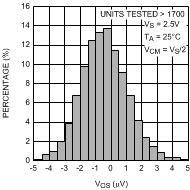 Figure 1. Offset Voltage Distribution
Figure 1. Offset Voltage Distribution
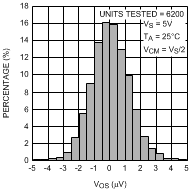 Figure 3. Offset Voltage Distribution
Figure 3. Offset Voltage Distribution
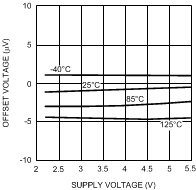 Figure 5. Offset Voltage vs. Supply Voltage
Figure 5. Offset Voltage vs. Supply Voltage
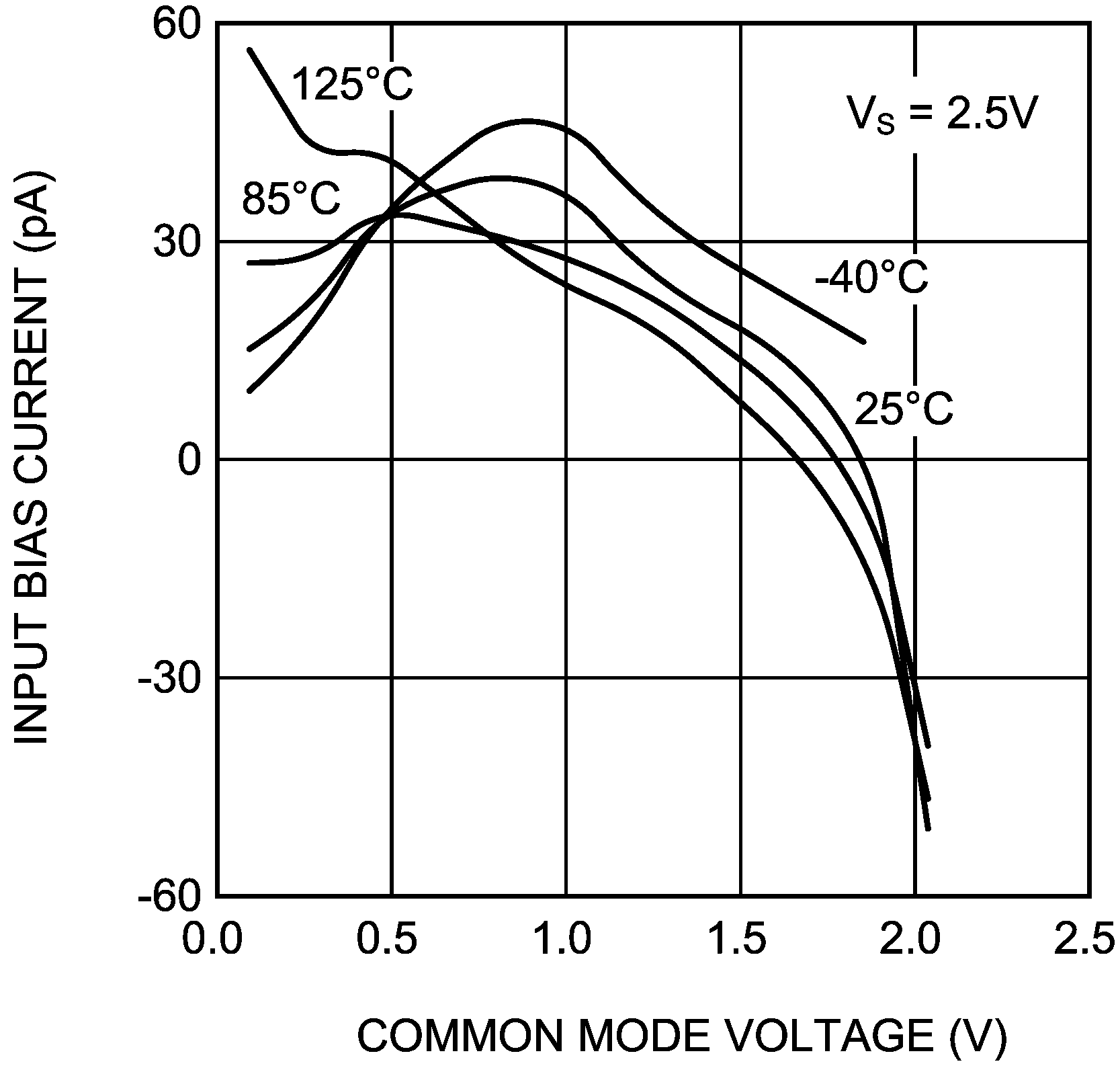 Figure 7. Input Bias Current vs. VCM
Figure 7. Input Bias Current vs. VCM
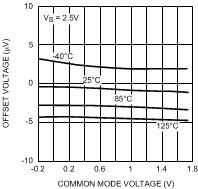 Figure 9. Offset Voltage vs. VCM
Figure 9. Offset Voltage vs. VCM
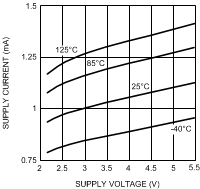 Figure 11. Supply Current vs. Supply Voltage (Per Amplifier)
Figure 11. Supply Current vs. Supply Voltage (Per Amplifier)
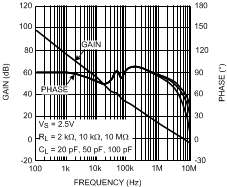 Figure 13. Open Loop Frequency Response
Figure 13. Open Loop Frequency Response
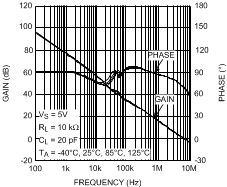 Figure 15. Open Loop Frequency Response Over Temperature
Figure 15. Open Loop Frequency Response Over Temperature
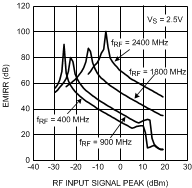 Figure 17. EMIRR vs. Input Power
Figure 17. EMIRR vs. Input Power
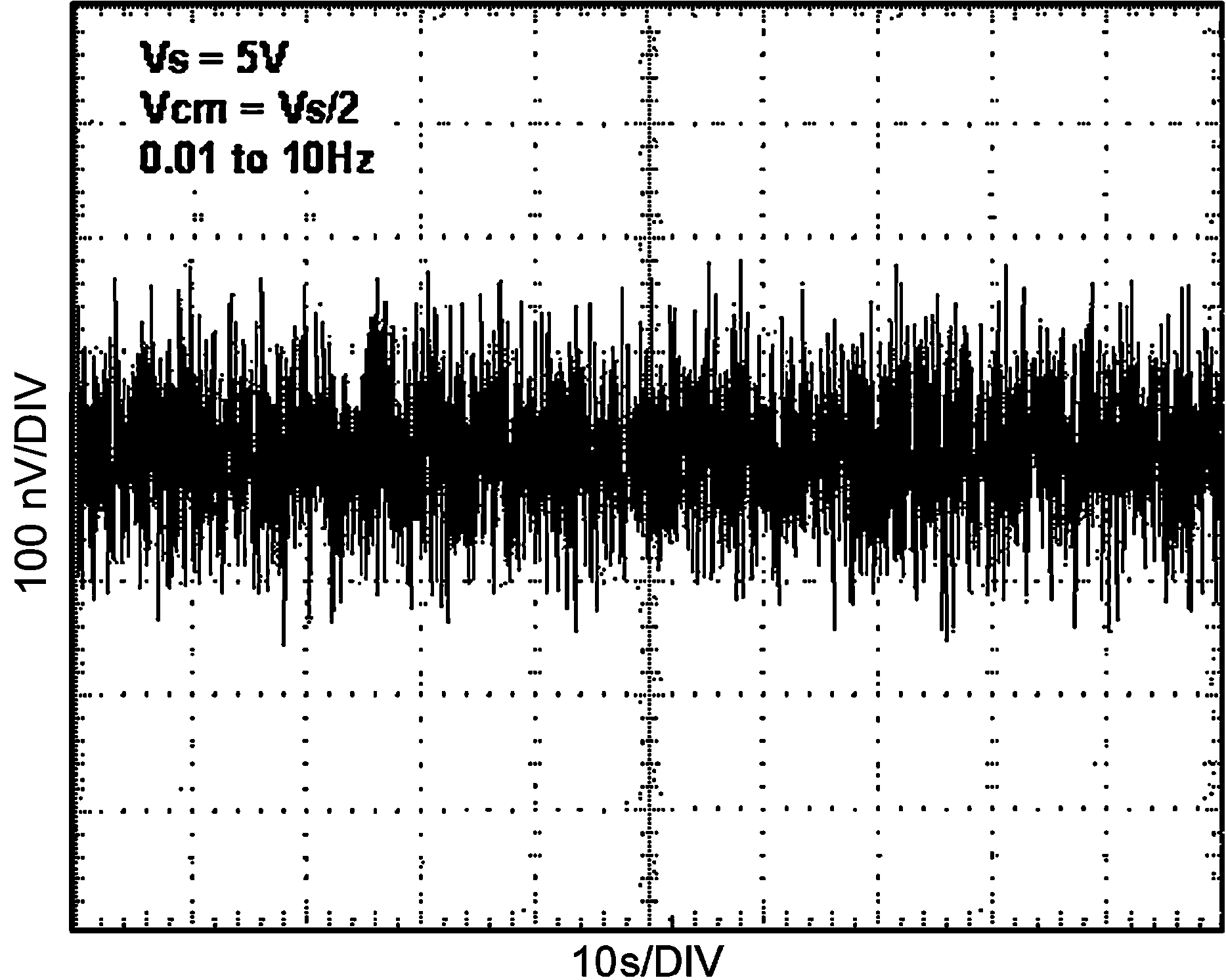 Figure 19. Time Domain Input Voltage Noise
Figure 19. Time Domain Input Voltage Noise
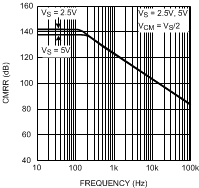 Figure 21. CMRR vs. Frequency
Figure 21. CMRR vs. Frequency
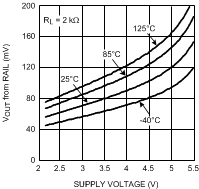 Figure 23. Output Swing High vs. Supply Voltage
Figure 23. Output Swing High vs. Supply Voltage
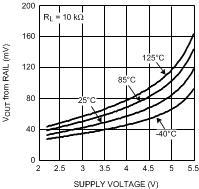 Figure 25. Output Swing High vs. Supply Voltage
Figure 25. Output Swing High vs. Supply Voltage
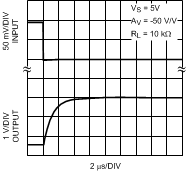 Figure 27. Overload Recovery Time
Figure 27. Overload Recovery Time
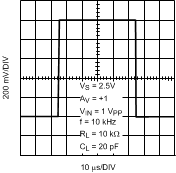 Figure 29. Large Signal Step Response
Figure 29. Large Signal Step Response
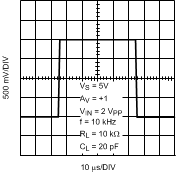 Figure 31. Large Signal Step Response
Figure 31. Large Signal Step Response
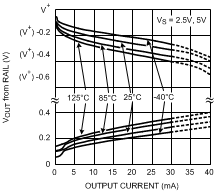 Figure 33. Output Voltage vs. Output Current
Figure 33. Output Voltage vs. Output Current
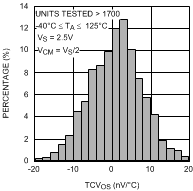 Figure 2. TCVOS Distribution
Figure 2. TCVOS Distribution
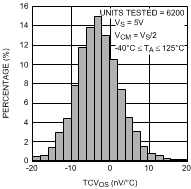 Figure 4. TCVOS Distribution
Figure 4. TCVOS Distribution
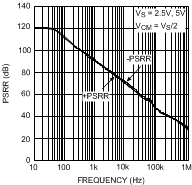 Figure 6. PSRR vs. Frequency
Figure 6. PSRR vs. Frequency
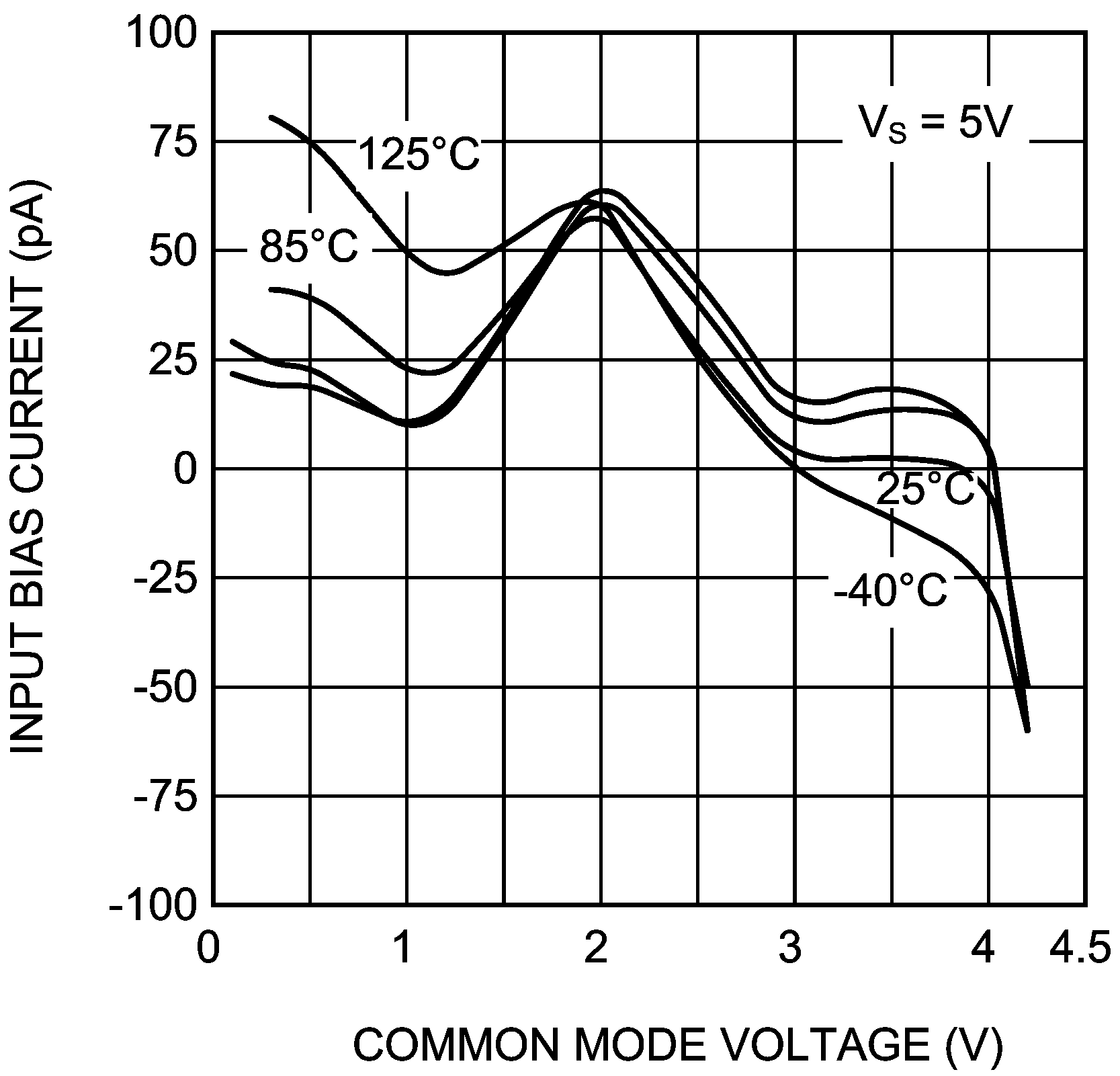 Figure 8. Input Bias Current vs. VCM
Figure 8. Input Bias Current vs. VCM
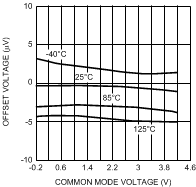 Figure 10. Offset Voltage vs. VCM
Figure 10. Offset Voltage vs. VCM
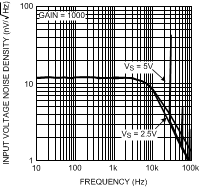 Figure 12. Input Voltage Noise vs. Frequency
Figure 12. Input Voltage Noise vs. Frequency
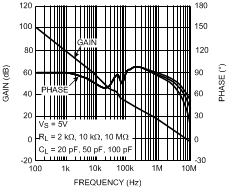 Figure 14. Open Loop Frequency Response
Figure 14. Open Loop Frequency Response
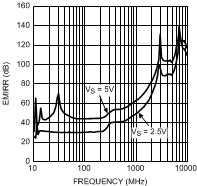 Figure 16. EMIRR vs. Frequency
Figure 16. EMIRR vs. Frequency
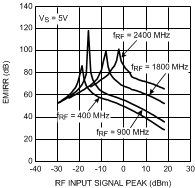 Figure 18. EMIRR vs. Input Power
Figure 18. EMIRR vs. Input Power
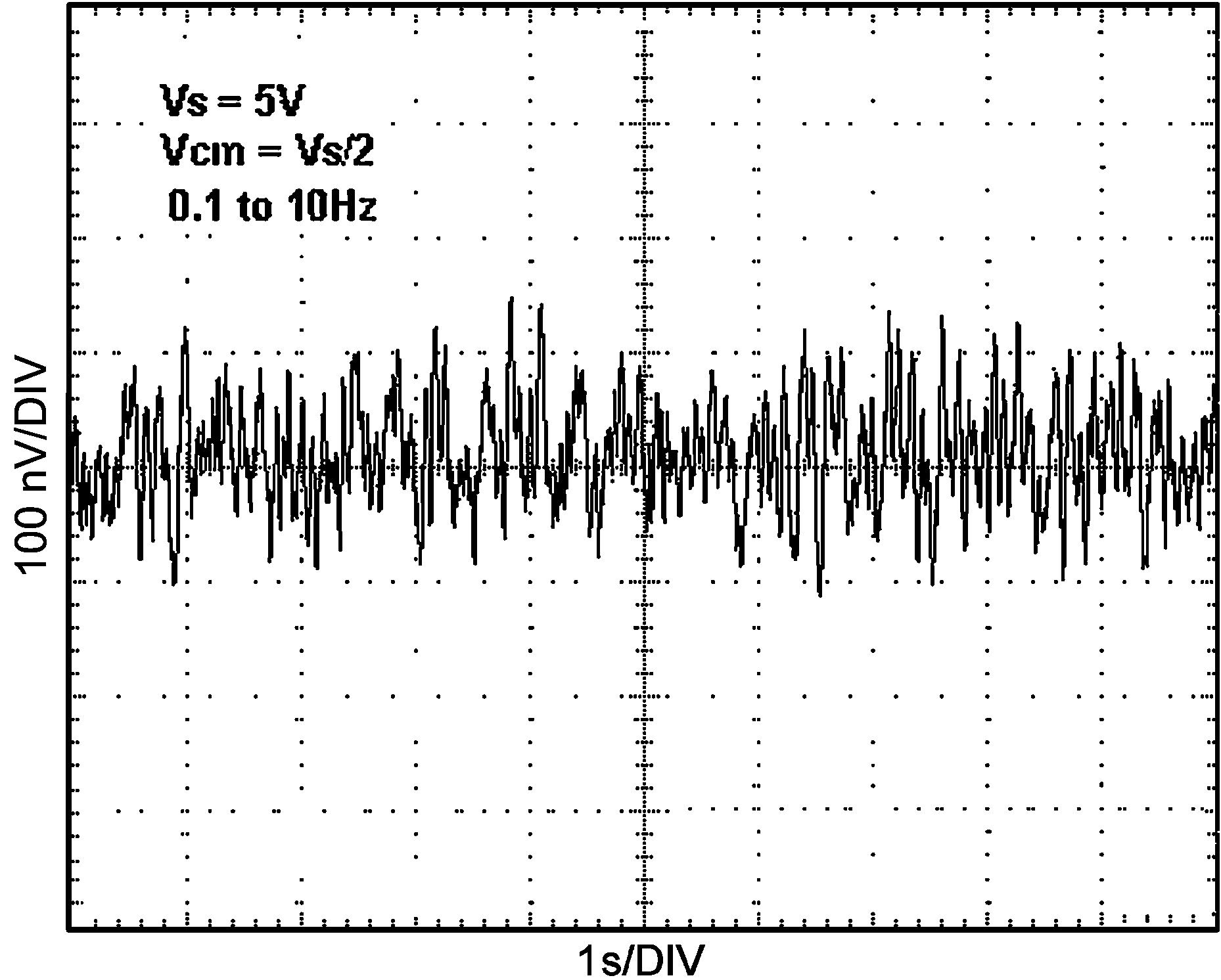 Figure 20. Time Domain Input Voltage Noise
Figure 20. Time Domain Input Voltage Noise
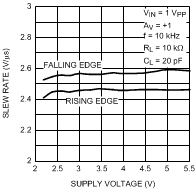 Figure 22. Slew Rate vs. Supply Voltage
Figure 22. Slew Rate vs. Supply Voltage
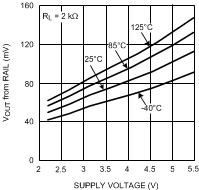 Figure 24. Output Swing Low vs. Supply Voltage
Figure 24. Output Swing Low vs. Supply Voltage
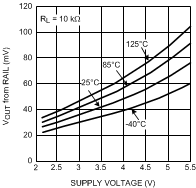 Figure 26. Output Swing Low vs. Supply Voltage
Figure 26. Output Swing Low vs. Supply Voltage
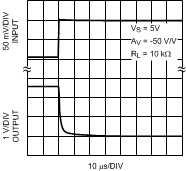 Figure 28. Overload Recovery Time
Figure 28. Overload Recovery Time
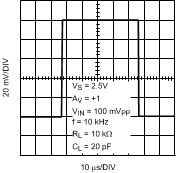 Figure 30. Small Signal Step Response
Figure 30. Small Signal Step Response
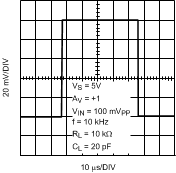 Figure 32. Small Signal Step Response
Figure 32. Small Signal Step Response
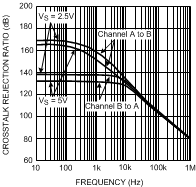 Figure 34. Cross Talk Rejection Ratio vs. Frequency (LMP2022)
Figure 34. Cross Talk Rejection Ratio vs. Frequency (LMP2022)
7 Detailed Description
7.1 Overview
The LMP202x are single and dual precision operational amplifiers with ultra low offset voltage, ultra low offset voltage drift, and very low input voltage noise with no 1/f and extended supply voltage range. The LMP202x offer on chip EMI suppression circuitry which greatly enhances the performance of these precision amplifiers in the presence of radio frequency signals and other high frequency disturbances.
The LMP202x utilize proprietary auto zero techniques to measure and continuously correct the input offset error voltage. The LMP202x have a DC input offset voltage with a maximum value of ±5 μV and an input offset voltage drift maximum value of 0.02 µV/°C. The input voltage noise of the LMP202x is less than 11 nV/√Hz at a voltage gain of 1000 V/V and has no flicker noise component. This makes the LMP202x ideal for high accuracy, low frequency applications where lots of amplification is needed and the input signal has a very small amplitude.
The proprietary input offset correction circuitry enables the LMP202x to have superior CMRR and PSRR performances. The combination of an open loop voltage gain of 160 dB, CMRR of 142 dB, PSRR of 130 dB, along with the ultra low input offset voltage of only −0.4 µV, input offset voltage drift of only −0.004 µV/°C, and input voltage noise of only 260 nVPP at 0.1 Hz to 10 Hz make the LMP202x great choices for high gain transducer amplifiers, ADC buffer amplifiers, DAC I-V conversion, and other applications requiring precision and long-term stability. Other features are rail-to-rail output, low supply current of 1.1 mA per amplifier, and a gain-bandwidth product of 5 MHz.
The LMP202x have an extended supply voltage range of 2.2 V to 5.5 V, making them ideal for battery operated portable applications. The LMP2021 is offered in 5-pin SOT-23 and 8-pin SOIC packages. The LMP2022 is offered in 8-pin VSSOP and 8-Pin SOIC packages.
7.2 Functional Block Diagram

7.3 Feature Description
The amplifier's differential inputs consist of a non-inverting input (+IN) and an inverting input (–IN). The amplifier amplifies only the difference in voltage between the two inputs, which is called the differential input voltage. The output voltage of the op-amp Vout is given by Equation 1:
where AOL is the open-loop gain of the amplifier, typically around 100dB (100,000x, or 10uV per Volt).
7.4 Device Functional Modes
7.4.1 EMI Suppression
The near-ubiquity of cellular, Bluetooth, and Wi-Fi signals and the rapid rise of sensing systems incorporating wireless radios make electromagnetic interference (EMI) an evermore important design consideration for precision signal paths. Though RF signals lie outside the op amp band, RF carrier switching can modulate the DC offset of the op amp. Also some common RF modulation schemes can induce down-converted components. The added DC offset and the induced signals are amplified with the signal of interest and thus corrupt the measurement. The LMP202x use on chip filters to reject these unwanted RF signals at the inputs and power supply pins; thereby preserving the integrity of the precision signal path.
Twisted pair cabling and the active front-end’s common-mode rejection provide immunity against low frequency noise (i.e. 60 Hz or 50 Hz mains) but are ineffective against RF interference. Figure 46 displays this. Even a few centimeters of PCB trace and wiring for sensors located close to the amplifier can pick up significant 1 GHz RF. The integrated EMI filters of LMP202x reduce or eliminate external shielding and filtering requirements, thereby increasing system robustness. A larger EMIRR means more rejection of the RF interference. For more information on EMIRR, please refer to AN-1698 (Literature Number SNOA497).
7.4.2 Input Voltage Noise
The input voltage noise density of the LMP202x has no 1/f corner, and its value depends on the feedback network used. This feature of the LMP202x differentiates this family from other products currently available from other vendors. In particular, the input voltage noise density decreases as the closed loop voltage gain of the LMP202x increases. The input voltage noise of the LMP202x is less than 11 nV/√Hz when the closed loop voltage gain of the op amp is 1000. Higher voltage gains are required for smaller input signals. When the input signal is smaller, a lower input voltage noise is quite advantageous and increases the signal to noise ratio.
Figure 35 shows the input voltage noise of the LMP202x as the closed loop gain increases.
 Figure 35. Input Voltage Noise Density decreases with Gain
Figure 35. Input Voltage Noise Density decreases with Gain
Figure 36 shows the input voltage noise density does not have the 1/f component.
 Figure 36. Input Voltage Noise Density with no 1/f
Figure 36. Input Voltage Noise Density with no 1/f
With smaller and smaller input signals and high precision applications with lower error budget, the reduced input voltage noise and no 1/f noise allow more flexibility in circuit design.